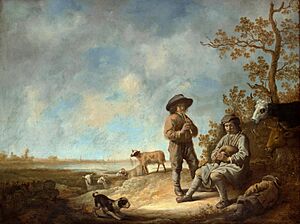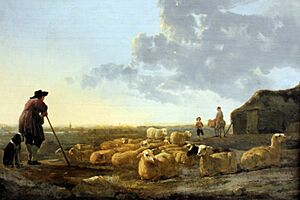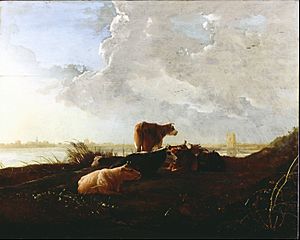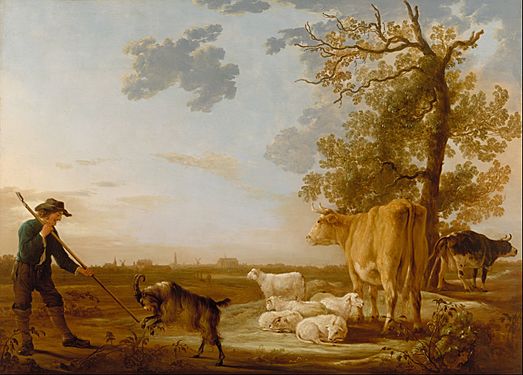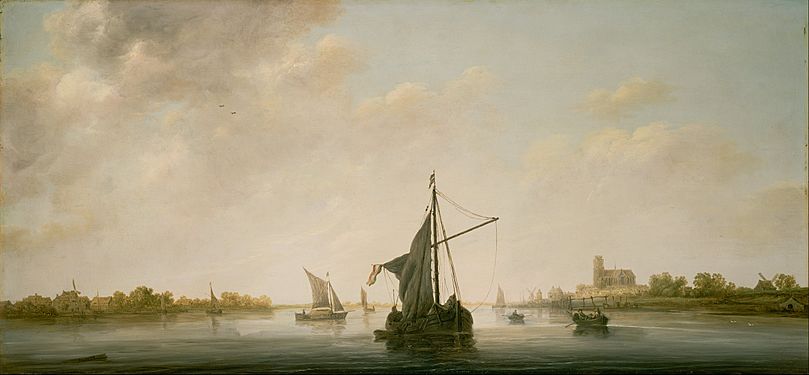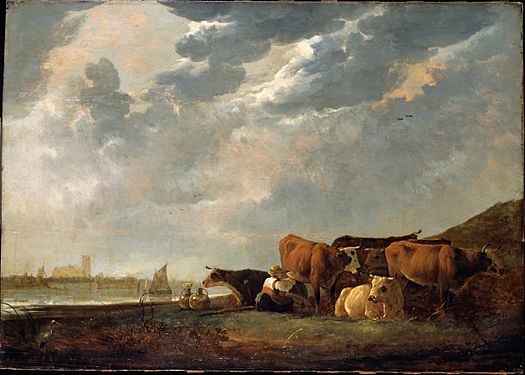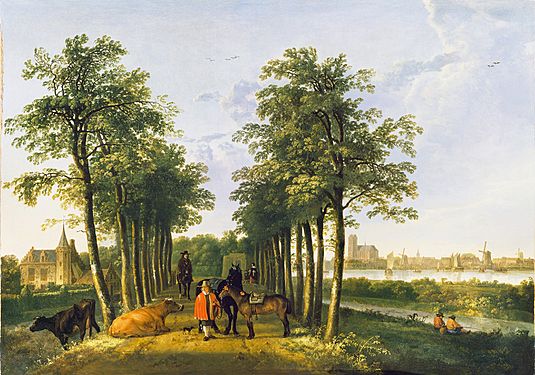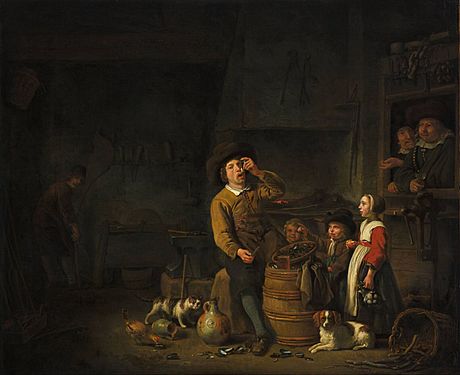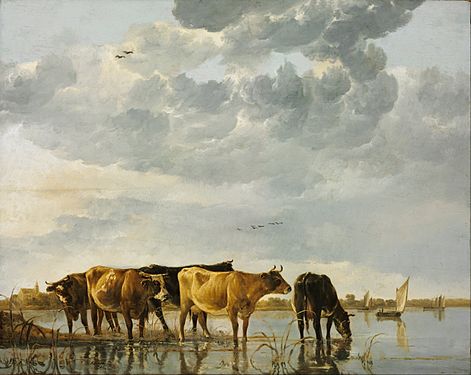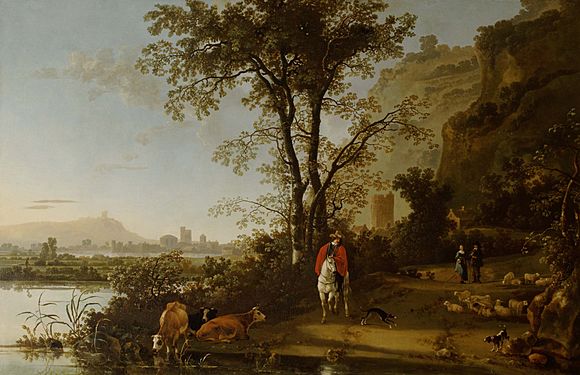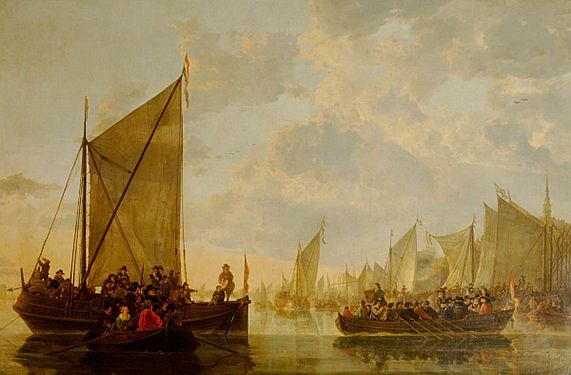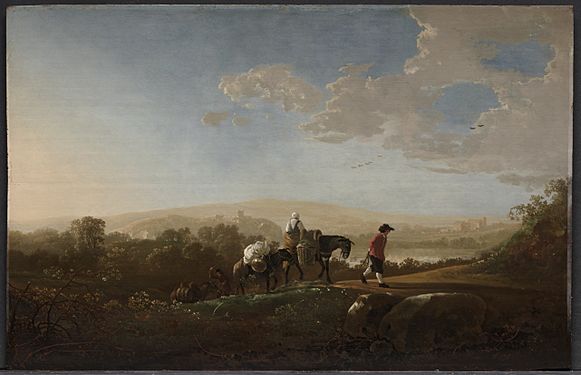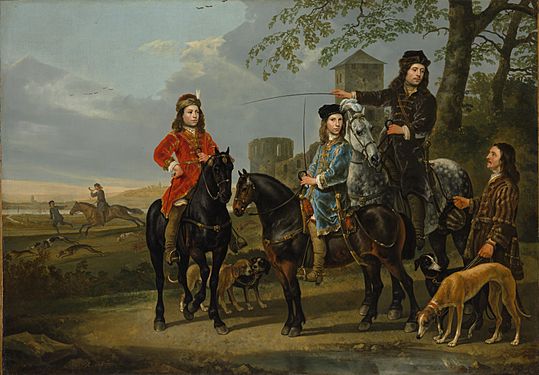Aelbert Cuyp facts for kids
Template:Infobox biography vcard Aelbert Jacobszoon Cuyp (Dutch pronunciation: [kœyp]) (or Cuijp; 20 October 1620 – 15 November 1691) was one of the most important Dutch Golden Age painters. He mostly painted beautiful landscapes. He was the most famous artist in his family. His father, Jacob Gerritszoon Cuyp, was also a painter and taught Aelbert. Aelbert Cuyp is well-known for his large paintings of Dutch riversides. These scenes often show a golden light from early morning or late afternoon. He was born and died in Dordrecht, a city in the Netherlands.
Contents
Biography of Aelbert Cuyp
Aelbert Cuyp came from a family of artists. His uncle Benjamin and grandfather Gerrit designed stained glass. His father, Jacob Gerritszoon Cuyp, painted portraits. Aelbert's father was his first teacher. They even worked together on many paintings.
Not much is known about Aelbert Cuyp's personal life. Even Arnold Houbraken, a historian who wrote about Dutch Golden Age painters, didn't have many details about him.
Cuyp painted actively for about twenty years, from 1639 to 1660. This time fits within the most important period of the Dutch Golden Age (1640–1665). He married Cornelia Bosman in 1658. After his marriage, he painted much less. People think his marriage might have played a role in him stopping his art career.

Cuyp's Painting Style
Aelbert Cuyp's painting style changed over time. He learned from other famous painters. You can see three main influences in his work:
- Jan van Goyen: From van Goyen, Cuyp learned how to use certain colors, like straw yellow and light brown. He also learned a "broken brush technique." This means using short brush strokes where colors are not blended smoothly. It was a bit like early impressionism.
- Jan Both: In the mid-1640s, Cuyp was influenced by Jan Both. Both had just returned from Rome and learned a new way to use light. Instead of light coming from the side, Both started painting light coming from behind the scene. This made paintings look deeper and brighter. Cuyp used this to create amazing sunsets and sunrises.
- His Father, Jacob Gerritsz Cuyp: Aelbert's father was a portrait painter. Aelbert started by painting landscapes. But over time, he began to include large figures and animals in the front of his paintings. This change is thought to be because of his father's influence. Sometimes, Aelbert even painted the landscape backgrounds for his father's portraits.
Cuyp's Famous Paintings
Cuyp's paintings are known for their beautiful sunlight. The light seems to sweep across the canvas, making small details shine. You can see golden light on a blade of grass, a horse's mane, or a cow resting by a stream. His paintings often show wide, open views of the countryside.
Cuyp also made excellent drawings. He used golden-brown ink to show distant views of cities like Dordrecht or Utrecht. He probably used these drawings as references for his paintings in his studio. Sometimes, the same part of a sketch appears in several different paintings.
Cuyp signed many of his works, but he rarely put a date on them. This makes it hard to know exactly when he painted each piece. Many paintings are thought to be by him, but some might be by other artists. For example, Abraham Calraet (1642–1722) also used the initials A.C., which can be confused with Cuyp's.
One of Cuyp's paintings, Landscape with a sunset (around 1655), can be seen at the Thyssen-Bornemisza Museum in Madrid, Spain. It is likely the only Cuyp painting in a public collection in Spain.
Why Some Paintings Are Misattributed
It can be very tricky to figure out if a painting is truly by Aelbert Cuyp. Here's why:
- Similar Styles: Cuyp's style was influenced by many artists. His most famous follower, Abraham van Calraet, copied Cuyp's style very well. This makes their paintings look very similar.
- Confusing Signatures: Aelbert Cuyp signed many paintings with "A. Cuyp." But many were left unsigned. Later, collectors might have added a similar signature. Also, some paintings were just marked with "A. C." for Aelbert Cuyp. However, Abraham van Calraet could also have used "A. C."
- Studio Work: Paintings from Cuyp's workshop were often marked with "A. C." This meant that Cuyp's students or assistants did most of the work. Cuyp might have just approved the final painting without touching the canvas much. This makes it hard to know how much of the work was truly his.
Because of these reasons, even art historians have sometimes been fooled. They have had to change their minds about which paintings were truly by Cuyp.
Later Life
After Aelbert Cuyp married Cornelia Boschman in 1658, he painted much less. His wife was a very religious woman. It's possible he became more involved with the church under her guidance. He was also active as a leader in the Reformed Church.
Legacy of Aelbert Cuyp
Even though we don't have a complete story of his life, and it's hard to know the exact order of his works, Aelbert Cuyp's style is very special. His paintings are unique because of the different influences he combined. However, because he worked with his father and had many imitators, it can still be hard to be sure if a painting is truly his. Abraham van Calraet's works are especially confusing. Even museum experts have had to re-examine many paintings once thought to be by Cuyp.
Gallery
- Aelbert Cuyp's paintings
-
Landscape with cattle
(c. 1639–1649)
National Gallery of Victoria -
Herdsmen with Cows
(c. 1645)
Dulwich Picture Gallery -
The Mussel Eater, c. 1650, Museum Boijmans Van Beuningen
-
Landscape with a Horseman, Figures, and Cattle, c. 1655, Waddesdon Manor
-
A Landing Party on the Maas at Dordrecht, 1655–1660, Waddesdon Manor. The other canvas that appears to show an event in the end stages of the Eighty Years' War is now in the National Gallery of Art, Washington.
-
Travelers in Hilly Countryside (c. 1650), Cleveland Museum of Art
-
Equestrian Portrait of Cornelis and Michiel Pompe van Meerdervoort with Their Tutor and Coachman (before 1653), Metropolitan Museum of Art
See also
 In Spanish: Albert Jacob Cuyp para niños
In Spanish: Albert Jacob Cuyp para niños



